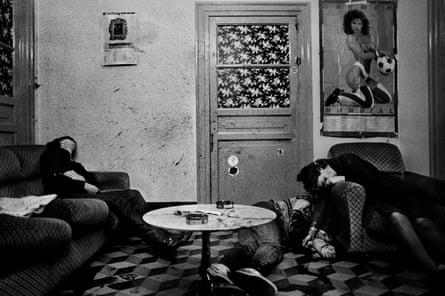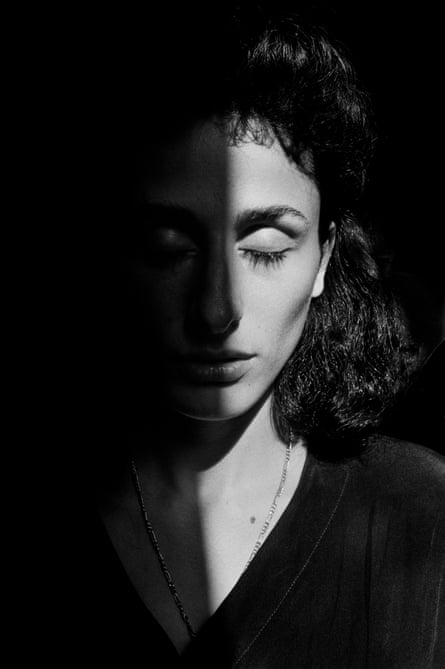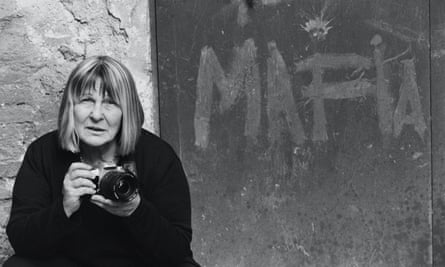Letizia Battaglia can still remember the first corpse she photographed: a man lying beneath an olive tree in a field in rural Sicily. It remains a viscerally unsettling image, made all the more so by its telling details: the dead man’s shoeless left foot, the resigned gaze of the policeman guarding the body, the olive leaves hanging low over the spreadeagled torso. The fact that he was a mafioso murdered in a local feud is, insists Battaglia, neither here nor there. “Everyone,” she says quietly, “is equal in death.”
What has stayed with her, over 40 years later, is the smell that hung in the summer air that day and was carried on the breeze. “It was very hot and he had been dead for a few days,” she says, drawing deeply on a cigarette. “Now, as soon as you ask about this photograph, it comes back to me. I can almost feel it, this atmosphere of death.”
We are sitting at a table in Battaglia’s modest flat in central Palermo, her home town, talking about Sicily’s bloody past – what the Italians call “the years of lead”. Now 84, her hair dyed pink as if in defiance of old age, Battaglia is an icon in her native city, the woman who captured the atmosphere of death like no other photographer throughout the dark days of the 1970s and 1980s.
Still passionately engaged in the social and political life of the city, she speaks about what she once called her “archive of blood” with a mixture of stoicism, anger and regret. “Photography changes nothing,” she says at one point. “Violence continues, poverty continues, children are still being killed in stupid wars.”

Yet Battaglia’s photographs were evidence that held the mafia to account: two of her images were crucial in proving former prime minister Giulio Andreotti’s links to organised crime, as they showed him with an important mafioso, Nino Salvo, whom he had denied knowing. Later, she will take me to see her latest venture, the grandly titled International Centre of Photography, a gallery and creative hub on a former industrial site on the edge of the city.
In one room, assistants are hanging a selection of her early work, originally published in Palermo’s left-wing newspaper, L’Ora. One striking photograph shows several mafiosa sitting in a row in a courtroom. The youngest is staring arrogantly at her camera, his finger pointed towards his mouth. “He is saying to me, ‘I will blow your brains out,’” says Battaglia, who lived with regular death threats for two decades.
“Letizia’s pictures confronted the mafia,” says Kim Longinotto, director of an extraordinary new film about Battaglia. “She faced up to the fear they instilled. She refused to be afraid at a time when it could have cost her her life.” Using Battaglia’s images alongside news footage and scenes from classic black and white Italian realist films, Shooting the Mafia is, among other things, a sustained riposte to romanticised Hollywood portrayals of the mafia.
“They called themselves men of honour,” says Longinotto. “But, as her photographs show, there was nothing honourable in what they did. Many of those they killed were young activists, trade unionists, truly honourable people challenging corrupt politicians.”
In one revealing sequence from the 1980s, Battaglia and her friends stage an impromptu exhibition of her photographs in the village of Corleone, a mafia stronghold that has produced several bosses. The locals initially stare at them out of curiosity then wander away in silence. “It was an act of incredible bravery and defiance.” says Longinotto. “Letizia was forcing them to look directly at what the mafia were doing, but the people were afraid even to be seen looking at the photographs. That is how deep the fear ran.”

Battaglia’s rebellious spirit found its true expression in photography. Raised in postwar Palermo, save for a few years when her family relocated to Trieste, she reacted against her strict upbringing by running away to marry a rich older man when she was just 16. Against the odds, the marriage lasted over 20 years and produced three children, whom she took with her when she finally returned to Sicily.
Her ambition was to be a writer, but her fledgling journalistic career came to an abrupt end when she first picked up a camera at the age of 40. “I thought, ‘With this in my hand, I can take on the world,’” she says, her eyes lighting up. “Suddenly, I no longer needed kisses or caresses. Instead, I had this confidence, this independence. But it was not just about expressing myself. With the camera, I could also express the inquietude of the world.”

When I suggest that she is, at heart, a romantic, she bridles and fixes me with a fierce stare. “No! Photography is not a romantic thing for me. It is not so banal. To create a truly great photograph, you have to work hard and be free. A good photographer needs to be inside the photograph somehow so that the viewer can feel their presence.”
Entirely self-taught, she did not realise how powerful her photographs were until years after she took them. “No one told me they were good, but I could feel something. The men photographers kept me apart, they did not invite me to their gatherings and I did not care. It was only in retrospect that I realised I was a storyteller who used images instead of words.”
The story she told remains one of the most compellingly powerful in photography’s history. But alongside the horror, there is a strange kind of formal beauty that rests in her intuitive grasp of composition and use of shadow and light. “When you are shooting the dead, using black and white is a way to be delicate, respectful. It creates its own silence and silence was very important for me.”
A bleak photograph from 1982 is a case in point: three bodies lie slumped over chairs in a nondescript room, a sex worker and two of her clients, all killed for using heroin that was not supplied by the mafia. “It was such a small room,” she says, “and when I arrived it was full of people: policemen, doctors, magistrates. I had to wait there until, one by one, they left and I was alone with the bodies. It took an eternity, but I had to be alone out of respect for the dead.”
There are silence and beauty too in her heartbreaking portrait of Rosario Schifani, which was taken at the funeral of her husband, a bodyguard killed in a car bomb that targeted Battaglia’s friend Giovanni Falcone, a fearless anti-Mafia judge. His death, and that of his associate Paolo Borsellino the same year, caused Battaglia to retreat from the world for a time.
“I was in despair,” she says, looking pained. “There were too many dead people. Falcone and Borsellino were symbols of hope, of change, but I loved them as people. It was too much for me. I wanted to die. I had to rebuild myself, but it was so hard, so painful.”

At moments like this, one catches a glimpse of the heavy price Battaglia paid for her bravery and commitment. Things have changed for the better, she says, but the Mafia remain a malign invisible force in international crime and politics. Her energies are directed elsewhere these days. She is working on an extended project called Nude Palermo. “It is people of every age and gender – and now, finally, they are not afraid to show themselves. It is not sexy, it is pride, it is strength. Women are freer inside now, they do not wait for the man’s permission.”
She smiles and lights another cigarette. “I am optimistic despite all I have seen,” she says, blowing smoke into the air, “I have to be. Not for me, but for the young people. I can see that they need hope and I have to give it to them. Politics shows them only hate. I can show them beauty. My heart has not hardened with age. Always, there is hope, but you must fight for it.”

Comments (…)
Sign in or create your Guardian account to join the discussion